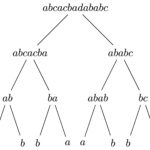My modules, research and activities during my time at the University of St Andrews kindled my interest in the following areas of mathematics:
- Group and semigroup theory
- Computational mathematics
- Fluid dynamics
- Analysis, namely in ergodic theory and dynamical systems
My past involvement with some of these is detailed in the sections below. Now that I have graduated and am working in a non-technical field, I keep an interest in these areas of mathematics and am trying to work my way through some textbooks to extend my knowledge.
Honours project: intermittency in Dynamical Systems
My final year undergraduate Honours project at St Andrews (closest thing I have to a Masters thesis) was on intermittency in dynamical systems. Under the supervision of Dr Mike Todd, I created a summary of standard results about the Manneville-Pomeau interval map, including its symbolic representations, existence of an absolutely continuous invariant measure, and polynomial decay of correlations. Feel free to contact me (tom dot contileslie at gmail dot com) for more details. The final product is available here:
Below are some articles and books that I have seen through my research on intermittency that I would recommend. I think I understood at least parts of these works, and they were certainly useful to me.
- Liverani, C., Saussol, B. and Vaienti, S., 1999. A probabilistic approach to intermittency. Ergodic Theory and Dynamical Systems, 19(3), pp.671-685.
- This paper introduces one of the more common parametrisations of Manneville-Pomeau maps:
$$T(x) = \begin{cases}x(1+2^\alpha x^\alpha)&x\in[0,1/2)\\2x-1&x\in[1/2,1]\end{cases}$$ - It also proves (non-constructively, using transfer operators to find the density) that the Manneville-Pomeau map has an absolutely continuous invariant measure, and proves some properties of this measure.
- This paper introduces one of the more common parametrisations of Manneville-Pomeau maps:
- Young, L., 1999. Recurrence times and rates of mixing. Israel Journal of Mathematics, 110(1), pp.153-188.
- Introduces the often-used concept of “Young Towers”. A little bit of staring hard at the equations is needed to understand what’s going on, but they are fairly easy to visualise once you get the hang of it.
- A number of powerful statistical theorems about Young Towers then follow. For now I’ve been content looking at the simpler theorems.
- Baladi, V., 2000. Positive Transfer Operators And Decay Of Correlations World Scientific. Singapore: World Scientific.
- Section 3.5 of this book has an excellent summary of some historic results about nonuniform piecewise expanding maps (with the LSV parametrisation of the Manneville-Pomeau map as its main example).
- Isola, S., 1996. Dynamical zeta functions and correlation functions for non-uniformly hyperbolic transformations (Preprint).
- Though I haven’t ventured much into the zeta function part of this paper, the first two sections have some explicit calculations related to the Markov partitions of a class of maps including the Manneville-Pomeau map.
- Sarig, O., 2002. Subexponential decay of correlations. Inventiones mathematicae, 150(3), pp.629-653.
- This paper proves a recent result on decay of correlations for the Manneville-Pomeau map, and has an informative introduction—something often found in Sarig’s other papers too.
Participation in the St Andrews Computational Mathematics research group
Between May 2020 and June 2021, I was an active member of the St Andrews Computational Mathematics research group and their Wednesday meetings.
I wrote a blog post about my work on free bands in the summer of 2020 which you can see here. During the following semester, I mostly worked on strong semilattices of semigroups, and decomposing certain types of completely regular semigroups (such as Clifford semigroups) into such semilattices. Petrich and Reilly’s book on completely regular semigroups is a good place to look for more information on semilattice decomposition.
I participated in the research group for credit in my final semester of university, and implemented an automatic semigroup presentation simplifier jointly with Ben Spiers. We created a new GAP object representing a semigroup presentation to which Tietze transformations can be applied; the simplifier then cleverly applies a number of easy transformations to reduce the total length of the presentation. The final pull request is available here.
